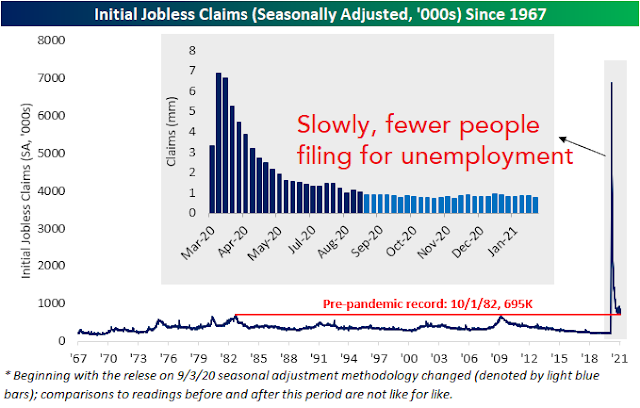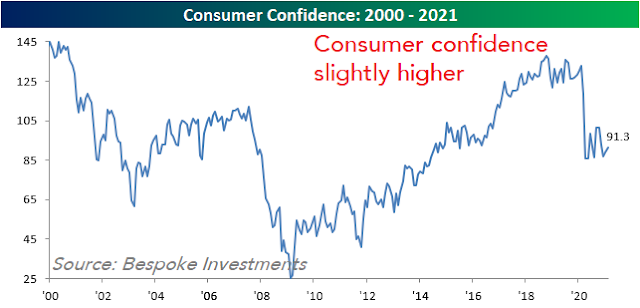Hello all – hard to believe the month is already over, we hope it was a good one for you.
Stocks saw gains this month, but there was a lot going on under the surface. For February, the Dow was up 3.2%, the S&P gained 2.6%, and the Nasdaq was the laggard with a 0.% return.
Stocks saw gains this month, but there was a lot going on under the surface. For February, the Dow was up 3.2%, the S&P gained 2.6%, and the Nasdaq was the laggard with a 0.% return.
The major markets took different paths this month. Usually they tend to move in the same direction, though at different speeds. A look at the chart below and you can see the tech-heavy Nasdaq falling off sharply in the latter part of the month.
Like we mentioned in the intro, there was a lot going on this month. Investors appear to be rotating out of previous high flyers like tech stocks and into investments that had been underperforming, thinking they have more room to rise.
Sectors that will do well as the economy continues to reopen, like airlines and cruise ships, saw a lot of interest. Money is also flowing into smaller stocks, too.
In the investing world, there are basically two investment categories: value and growth. Growth stocks are the high flyers that are expected to keep growing fast – like the tech stocks. Value stocks trade at prices lower than their fundamentals might suggest.
Anyway, growth stocks have been outperforming value stocks for years. However, value stocks saw a lot of interest in the latter part of this month. As you can see in the chart below, growth stocks fell sharply while value stocks held up.
Sectors that will do well as the economy continues to reopen, like airlines and cruise ships, saw a lot of interest. Money is also flowing into smaller stocks, too.
In the investing world, there are basically two investment categories: value and growth. Growth stocks are the high flyers that are expected to keep growing fast – like the tech stocks. Value stocks trade at prices lower than their fundamentals might suggest.
Anyway, growth stocks have been outperforming value stocks for years. However, value stocks saw a lot of interest in the latter part of this month. As you can see in the chart below, growth stocks fell sharply while value stocks held up.
_____
Bonds were also a big story this month - actually, they were probably the biggest story this month. Bonds are pretty boring, though, so they don’t get a lot of headlines.
Bond prices fell very sharply this month, which means their yields rose sharply. In your investment account, you’ll see your bond holdings lost value, but their interest payout will be higher.
Bond prices fell very sharply this month, which means their yields rose sharply. In your investment account, you’ll see your bond holdings lost value, but their interest payout will be higher.
In fact, the average dividend payout for stocks and the interest payout for bonds is now about the same. This means investors who bought stocks for their yields can get the same payout in a safer bond.
_____
So what’s going on here? Why the rotation out of bonds and out of high-flying stocks?
One reason is the strength of the economy. Economic data looks fairly solid and the pace of Covid vaccines is accelerating. That means economic data will keep getting better as the country continues to reopen. That’s good for stocks, particularly the beaten-down ones.
The other reason is an expected rise in inflation.
Fed chairman Jay Powell made comments in front of Congress this month that they would continue the record pace of money-printing stimulus, even long after their economic objectives have been met and even if inflation runs hot.
In addition to the current stimulus from the government, a $1.9 trillion stimulus bill is expected to be passed shortly, and there are rumors of a $3-4 trillion infrastructure bill coming within months, if not weeks. These are absolutely massive amounts of money being printed and it’s not inconceivable that it will stir up inflation.
Below is a look at the amount of money that has already been printed. Throughout the course of our history, the money supply has gradually risen. In the last year it has skyrocketed.
One reason is the strength of the economy. Economic data looks fairly solid and the pace of Covid vaccines is accelerating. That means economic data will keep getting better as the country continues to reopen. That’s good for stocks, particularly the beaten-down ones.
The other reason is an expected rise in inflation.
Fed chairman Jay Powell made comments in front of Congress this month that they would continue the record pace of money-printing stimulus, even long after their economic objectives have been met and even if inflation runs hot.
In addition to the current stimulus from the government, a $1.9 trillion stimulus bill is expected to be passed shortly, and there are rumors of a $3-4 trillion infrastructure bill coming within months, if not weeks. These are absolutely massive amounts of money being printed and it’s not inconceivable that it will stir up inflation.
Below is a look at the amount of money that has already been printed. Throughout the course of our history, the money supply has gradually risen. In the last year it has skyrocketed.
This amount of money printing begets the question, why isn’t there more inflation already? Well, there is some inflation out there - which we’ll get to shortly - but it’s a decline in the velocity of the money that has kept a lid on inflation. The “velocity” means that means it’s not cycling through the economy quickly. Take a look:
While the “velocity” of this money has fallen sharply during the shutdown, there is the perception that it will pick back up as the economy reopens. That increase in velocity, combined with the trillions more from new stimulus, is bound to stir up inflation.
We’re already seeing signs of inflation. The inflation metrics like PPI and CPI are showing increases. Plus, commodity indexes are rising quickly. The Bloomberg Commodity Index, which tracks 23 raw materials like oil and gas and copper and wheat and sugar, etc., rose at one of its strongest paces in a decade.
Here's a look at copper prices:
We’re already seeing signs of inflation. The inflation metrics like PPI and CPI are showing increases. Plus, commodity indexes are rising quickly. The Bloomberg Commodity Index, which tracks 23 raw materials like oil and gas and copper and wheat and sugar, etc., rose at one of its strongest paces in a decade.
Here's a look at copper prices:
As the economy reopens and inflation rises, stocks will tend to do better than bonds. In particular, the reopening stocks will outperform the tech stocks. Commodities will be an important part of the portfolio, too.
_____
Switching gears to the economy, which has shown a lot of strength.
The Federal Reserve Bank of Atlanta has raised its estimates for the GDP.
The Federal Reserve Bank of Atlanta has raised its estimates for the GDP.
The employment picture looks to be improving as fewer people are filing for unemployment.
The service and manufacturing sectors are both expanding (a number over 50 means expansion):
Retail sales are picking up:
Durable goods, which are items with a longer life like a phone or refrigerator, are also looking solid:
People still aren’t feeling good about the economy, though. Consumer sentiment rose only modestly last month and remains a long way from where it was before the virus.
Sentiment at small businesses rocketed back from the virus lows, but continued to move lower last month.
_____
Where does the market go from here?
Similar to January, the late-month selloff this month put the indexes at a more attractive level for a short-term investment (looking out a few weeks). We’d like to see them a little lower from this level before we’d get too excited, though.
We’re a little more cautious for the longer term. We think the economy will continue to improve, but the froth in the markets, along with a steady increase in inflation, could be a drag on stocks.
This commentary is for informational purposes and is not investment advice, an indicator of future performance, a solicitation, an offer to buy or sell, or a recommendation for any security. It should not be used as a primary basis for making investment decisions. Consider your own financial circumstances and goals carefully before investing. Past performance cannot guarantee results.
Similar to January, the late-month selloff this month put the indexes at a more attractive level for a short-term investment (looking out a few weeks). We’d like to see them a little lower from this level before we’d get too excited, though.
We’re a little more cautious for the longer term. We think the economy will continue to improve, but the froth in the markets, along with a steady increase in inflation, could be a drag on stocks.
This commentary is for informational purposes and is not investment advice, an indicator of future performance, a solicitation, an offer to buy or sell, or a recommendation for any security. It should not be used as a primary basis for making investment decisions. Consider your own financial circumstances and goals carefully before investing. Past performance cannot guarantee results.















